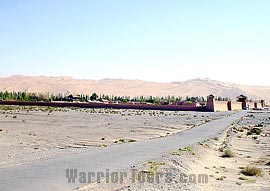Dunhuang Introduction
 At the mention of Dunhuang, what comes to mind? The vivid flying Apsarasa in Mogao Caves? The uncountable merchandise brought by overseas merchants via the ancient Silk Road? The grand Yumen Pass and Yangguan Pass of the Great Wall? Desolate desert where you can experience a lonely mind? Dunhuang is much more than those.
At the mention of Dunhuang, what comes to mind? The vivid flying Apsarasa in Mogao Caves? The uncountable merchandise brought by overseas merchants via the ancient Silk Road? The grand Yumen Pass and Yangguan Pass of the Great Wall? Desolate desert where you can experience a lonely mind? Dunhuang is much more than those.
Shaped like a dumbbell, Gansu Province is located in China's hinterland. The city lies on the westmost point of the dumbbell, at the far western point of Hexi Corridor. Covering an area of 31,200 sq km (about 7,709,681 acres), it is surrounded by mountains and gobis. As an important communication hub of the ancient Silk Road, foreign cultures and Chinese cultures once intermingled and even partly amalgamated in this city. Now, Dunhuang is a national tourist city hosting visitors from both home and abroad.
![]() History
History
Primitive societies lived in this region for centuries. During the Xia (21st -16th century BC), Shang (16th -11th century BC) and Zhou (11th -221 BC) dynasties, the area was called Guazhou and a tribe named Qiangrong resided there. In the Qin Dynasty (221-206 BC), Da Yue Zhi, a tribe strong enough to defeat the Qiangrong, conquered and controlled the area until the early years of the Western Han Dynasty (206-24 BC). At that time, Hun people invaded Hexi Corridor and drove the Da Yue Zhi away. Thus, the Hun became master of Hexi Corridor. Since the Hun was a big threat to the Western Han Dynasty, Emperor Wu asked his official, Zhang Qian, to take a long trip to the West Region (a vast area to the west of Yangguan and Yumen Passes) and to negotiate with the kingdoms in that area to fight against the Hun. After long and harsh battles, the Han finally controlled Hexi Corridor and Dunhuang was founded as a county. According to the historical books of the Han Dynasty, Dun means big and Huang means splendid. Thus, Dunhuang means grand and prosperous. The famous Silk Road began to thrive along Zhang Qian's trace, and Dunhuang became an important military, commercial and cultural center. During the Eastern Jin Dynasty (25-220), the battle again arose in this area. At that time, Buddhism flourished and Mogao Caves construction started in 366.
Sui Dynasty (581 - 618) finally stopped the disunion and Hexi Corridor was again at peace. Dunhuang County held trade fairs which attracted merchants from West Region, and also encouraged people from inner China to migrate and cultivate the land. Dunhuang rose to its acme in this prosperous and stable period. Tubo people (early Tibetan) occupied Hexi Corridor for 67 years after the ten years' war with the Tang Dynasty (618 - 907). In the year 1036, Xixia Kingdom controlled Hexi Corridor and in 1227 the Mongolian army conquered Dunhuang. Dunhuang became an important military port for the Mongolian army since the Mongols were trying to dominate the West. The Ming Dynasty (1368 - 1644) moved people back to inner lands and shrunk to the east of the Great Wall. Thus, Hexi Corridor once again was under the control of nomad tribes. In 1715, the Qing Dynasty (1644 - 1911) recaptured the Hexi Corridor and began to march to the West Region. People from Gansu, Turpan and other places of inner China were moved to Dunhuang and began to cultivate again. Today Dunhuang is a city focused on tourism and agriculture.
![]() Things to Do
Things to Do
The Mogao Caves, Bingling Thousand Buddha Caves, White Horse Dagoba, and many other cultural relics scattered in Dunhuang show the amazing techniques of the intelligent artisans. Crescent Lake, Echoing-sand Mountain, Yangguan Pass and Yumen Pass standing for centuries silently tell the ancient stories.
![]() Weather
Weather
Because of the long time racial integration in the Dunhuang area, there are now over 40 nationalities living in Dunhuang. Han, Hui, Tibetan, Mongol, Manchu and Uighur are the main residents. Dunhuang has insufficient annual rainfall with an average maximum temperature of 32.8 oC (91 oF) in June and lowest temperature of -15.6 oC (3.9 oF) in January. Sandstorms and wind visit Dunhuang frequently. The temperature changes sharply after sunset, so sunglasses, scarves, and coats are necessary while traveling.
![]() Transportation
Transportation
It's easy to get to Dunhuang since the Dunhuang Airport is just 13 km (8.07 miles) from the downtown area. Flights to Lanzhou, Xian, Beijing, Urumqi, Jiayuguan Pass, etc., can be found there. Dunhuang Railway Station, which opened March 3 rd , 2006, can transfer tourists to Lanzhou and Jiuquan. Dunhuang Coach Station in Mingshan Lu operates long distance coaches to Jiuquan, Lanzhou, Xian, Hami, Turpan, Urumqi, Golmud, etc. Since the attractions are quite far from the downtown area, visitors can hire a taxi. Just remember to bargain with the driver beforehand.
![]() Travel Tips
Travel Tips

